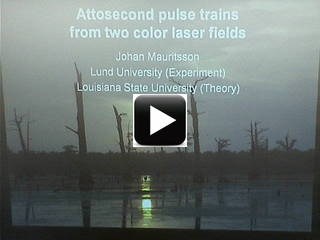We present how the generation of attosecond pulse trains can be controlled using a two color driving field, consisting of an infrared (IR) laser and its second harmonic. Consecutive half cycles in this field differ beyond the simple sign change that occurs in a one color field and have very different shapes and amplitudes. This sub-cycle structure, which governs the generation of the attosecond pulses, depends strongly on the relative phase and intensity of the two fields, thereby providing additional control of the generation process. We present both spectral and temporal measurements of the generated attosecond pulse trains. We find that we can tune the central frequency by changing the relative phase between the two driving fields and that trains of attosecond pulses with only one pulse per IR cycle are generated for a wide range of parameters.
When the attosecond pulses interact with a gas of atoms, electron wave packets are created if the photon energy exceeds the ionization potential. The wave packets are temporally localized with properties that are directly inherited from the attosecond pulses. If the ionization takes place in the presence of a laser field an energy exchange between the electrons and the field occurs. The amount of energy exchanged depends on the timing with respect to the phase of the laser field when the electrons are injected into the continuum. Using trains with only one pulse per IR cycle, all the wave packets are injected with the same timing with respect to the dressing IR field, thus enabling us to measure their dynamics in the dressed continuum. Projections of the final three dimensional electron distributions are measured using a velocity map imaging spectrometer.
 Other video options
Other video options
To begin viewing slides, click on the first slide below. (Or, view as pdf.)
![[01]](tn/01.jpg)
![[02]](tn/02.jpg)
![[03]](tn/03.jpg)
![[04]](tn/04.jpg)
![[05]](tn/05.jpg)
![[06]](tn/06.jpg)
![[07]](tn/07.jpg)
![[08]](tn/08.jpg)
![[09]](tn/09.jpg)
![[10]](tn/10.jpg)
![[11]](tn/11.jpg)
![[12]](tn/12.jpg)
![[13]](tn/13.jpg)
![[14]](tn/14.jpg)
![[15]](tn/15.jpg)
![[16]](tn/16.jpg)
![[17]](tn/17.jpg)
![[18]](tn/18.jpg)
![[19]](tn/19.jpg)
![[20]](tn/20.jpg)
![[21]](tn/21.jpg)
![[22]](tn/22.jpg)
![[23]](tn/23.jpg)
![[24]](tn/24.jpg)
![[25]](tn/25.jpg)
![[26]](tn/26.jpg)
![[27]](tn/27.jpg)
![[28]](tn/28.jpg)
![[29]](tn/29.jpg)
![[30]](tn/30.jpg)
![[31]](tn/31.jpg)
![[32]](tn/32.jpg)
![[33]](tn/33.jpg)
![[34]](tn/34.jpg)
![[35]](tn/35.jpg)
![[36]](tn/36.jpg)
![[37]](tn/37.jpg)
![[38]](tn/38.jpg)
![[39]](tn/39.jpg)